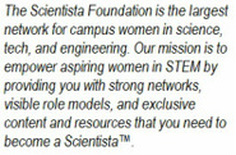|
9/19/2012 4 Comments Scientista 101: What is an MD/PhD? Learn what it takes to become a physician-scientista! By Abby Schiff So you want to be a physician-scientist... Do you dream of having multiple letters after your name? Spending the next eight to seventeen years in school? Graduating from medical school without debt? Exploring questions that bridge basic science and clinical medicine? If you do, perhaps an MD/PhD is for you. Physician-scientist training programs educate people to consider biomedical problems from both medical and scientific perspectives. Students learn to see and treat patients, but also do advanced work on problems of their choosing that touch on health--usually in the sciences, but occasionally in the social sciences or humanities in fields like economics, epidemiology or medical anthropology. The hope is people trained in both areas will use their knowledge of medicine and patient care to ask good questions and discover new insights that bridge their fields of study. Physician-scientists can do original research, see patients in medical clinics, or divide their time between the two. A standard MD/PhD program involves completing the first three to four semesters of medical school, which teach preclinical skills such as anatomy and physiology, and patient skills like taking a medical history and performing a physical exam. At this point, MD/PhD students depart to complete their PhD. After the dissertation is completed and defended, MD/PhD students return to finish the clinical years, or medical school years three and four, where students see patients and experience different medical specialties and settings. Depending on the length of the PhD and accommodations given to MD/PhD students, the program may take seven to nine (or more) years to complete. After this process is finished, students often do medical internships and residencies in order to practice medicine, and/or pursue postdoctoral fellowships (postdocs) to continue their research careers. "A formal MD/PhD program comes with important perks, including funding, mentorships, and training resources."  Fact: MD/PhDs work with patients without a medical collaborator. Why would anyone want to enter such a long program? After all, there are other ways to become a practicing physician-scientist. But a formal MD/PhD program comes with important perks, including funding, mentorships, and training resources. First of all, programs recognize that, generally, research science doesn’t pay as well as clinical medicine, a fact which leads many medical graduates to avoid research while they pay off their medical school loans. Most MD/PhD programs at least partially fund their students. In the US, the National Institutes of Health has a funding mechanism called the Medical Scientist Training Program (MSTP) that has accredited 45 institutions to administer their funding; MSTP students receive grants to cover tuition for all 7+ years and stipends to cover housing and expenses. Another advantage of structured MD/PhD programs are the mentorships they offer during the research years. PhD students can take classes with experts in their fields and gain lab experience; an MD graduate starting a postdoc without substantial lab experience would still be expected to publish without the advantages of graduate school. Finally, MD/PhD programs provide tailored resources for dual-degree students, such as program directors and advisors to guide their choices of labs and residency programs, seminars, special clinics to help students maintain their clinical skills, retreats, and other events to build a sense of community among students and alumni. Finally, after the program is over, physician-scientists can work with patients and patient samples without a medical collaborator, and often have an advantage over their MD or PhD colleagues in getting grants and faculty appointments relative to their post-graduate training Of course, as I have learned as an MD/PhD applicant talking to current students and practicing physician-scientists, this type of program has its downsides as well. Some pointed out that if MD/PhD students practiced medicine for the 3-5 years of their PhD, they could make the money for tuition and stipend provided by MSTP. Others said the MD/PhD affected their personal lives. Because of the program’s length, the medical residency, with its extremely demanding schedule, is delayed until doctors are in their early 30’s, which can make it difficult to start a family. On the academic side of things, because their educations switch between the medical and the scientific, MD/PhD candidates can feel like they perpetually have to catch up with advances in each field. However, almost everyone I spoke with touted the advantages of the training and was enthusiastic about how their work fused science and medicine. If you’re looking to work in a translational field, and you’re excited by the intersection of science and medicine, look for my upcoming columns, in which I’ll talk about the MD/PhD application and decision process.
4 Comments
8/12/2013 08:40:31 pm
A doctor should be a good scientist too which doesn't mean he should experiment on his patients. A doctor should understand the problems of his patient and learn from different scenarios, which can help him in the following treatments.
Reply
8/25/2013 09:48:01 am
I am an aspiring nurse and this has been really helpful to me
Reply
Your comment will be posted after it is approved.
Leave a Reply. |
Education BlogAbout ScientistaSubscribe!NEW!New PostsWhat's HotClick to set custom HTML
You Might Like...
Connect With UsLatest tweets |
The Scientista Foundation, Inc. All Rights Reserved © 2011-2021 | Based in NY | [email protected]
The Network for Pre-Professional Women in Science and Engineering
The Scientista Foundation is a registered 501(c)(3) -- Donate!
The Network for Pre-Professional Women in Science and Engineering
The Scientista Foundation is a registered 501(c)(3) -- Donate!


 RSS Feed
RSS Feed









